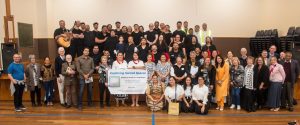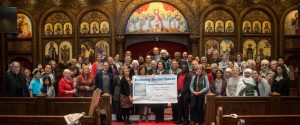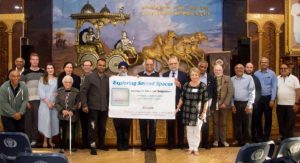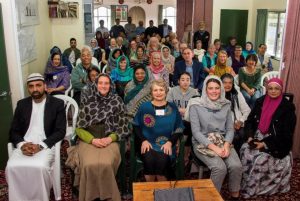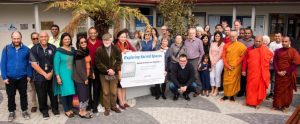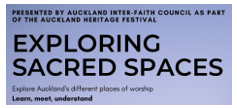This was the third year in a row that the Auckland Inter-Faith Council has organised “Exploring Sacred Spaces”, a series of public visits to various places of worship.
Since 2018 we have linked the initiative to the Auckland Heritage Festival, and have benefitted from the widespread promotion and advertising.
In 2019 we organised five separate visits, as shown in the poster above. The motto of the 2019 Festival as decided by Auckland Council was: “Journeys – Explore the stories of how our people travelled to Tāmaki Makaurau to create a shared future together”. This theme suited us well, as people who immigrated to New Zealand and settled in Auckland brought with them not only brought their language and culture but also their religious beliefs, and have been building places of worship.
Church of Jesus Christ of Latter Day Saints in Epsom (5 October)
This visit took place on one of the first beautiful sunny Saturdays of the season. Approximately 60 visitors (including 2 Local Board members) and 200 members of the church took part. The hosting church had a very well-prepared programme of information and entertainment. After being welcomed in the chapel, the guests were divided into small groups to be shown around the venue by guides. At each of the eight stations of this tour, a different speaker would elaborate on the programme offered there, and take questions. We were shown the Primary Education Room and enjoyed a song from some of the young children. We were also shown classrooms used for courses on Self-Reliance, Young Women’s group, Young Men’s group, Family History, the pool for Baptism, the Relief Society and the Chapel. When the tours were completed we were offered some light refreshments and treated to three powerful and joyful cultural performances: Tongan and Samoan dances as well as Maori singing and kapa haka.
St Mark’s Coptic Orthodox Church in Birkdale (8 October)
This tour was organised by Beate Matthies in conjunction with the parish priest of the Coptic Community Father Bishoy. The community comes from Egypt, and trace their church history back to the Apostle Mark. There was a wonderful turnout with more than 65 visitors (and 5 members of the congregation). The interior had just been redone a few months earlier and the members were very happy to show us around the beautiful wood carvings and images. After Beate’s welcome on behalf of the Auckland Inter-Faith Council, we watched a movie in which the history of the Coptic Church was explained. Fr Bishoy then added information about the Auckland church and answered a range of questions with the greatest politeness and patience – and obvious love for his faith. The church building was originally a factory and the Coptic Orthodox community bought this factory as well as an adjacent factory which is today used as multi-purpose hall (meals, celebration, games). After the tour we were all invited to a cuppa and Arabic sweets.
Shree Swaminarayan Hindu Temple in Papatoetoe (12 October)
About 25 guests visited the Hindu Temple in Papatoetoe. We were welcomed by the leader of the local community and a Hindu priest who started the event with a chanted prayer of blessing. Ruth Cleaver gave some background on the Auckland Inter-Faith Council and the initiative “Exploring Sacred Spaces.” Using slides, Mr Manish Tanna explained the history of Hinduism and how it spread. We then heard the life story of Lord Shri Swaminarayan who lived 200 years ago and was a nomadic hermit and teacher who re-introduced non-violent yagnas (offerings). He was also a prolific writer and is the author of Shikshapatri (scripture with detailed instructions on how to live a spiritually uplifting life). The temple in Papatoetoe, a former Samoan church, was opened in 2008 and belongs to the ISSO Community (“The Original Shree Swaminarayan Sampraday”). Many of their members have received awards for their humanitarian work and recognition for their business achievements..
Three outstanding members shared their testimonies about their journey to New Zealand. One speaker, Dr Anil Channa, was born in Kashmir, which he remembers as paradise. His upbringing was influenced by the motto: “There is only one truth and learned persons call it by many names”. He went to a Catholic school in Kashmir of which he spoke very highly. He said that this education gave him values in his early life, and he was taught to share his talents and his wealth. After his medical studies he worked in war-torn Libya as a surgeon but then was not able to return to Kashmir. He gave many examples of how he supported and helped others and has fought for justice. He set up the “Overseas Doctors Association” when he was new in New Zealand and was not receiving recognition for his medical degrees. More recently, he set up the charity “4Kids Foundation” in Bombay. After the presentations and testimonials, we were shown around the temple and learned about the different Avatars of Lord Vishnu. We were able to ask any questions before enjoying a spicy Indian lentil meal. Those who were able to stay longer were shown the new construction site behind the temple. The foundation and the first walls of the new Community Centre gave an impression of the huge building project. The centre is to open mid-2020 and will be able to host more than 1000 people in addition to several rooms for teaching and offices.
West Auckland Masjid & Islamic Centre in Ranui (20 October)
About 50 persons and 10 members of the host community participated in the visit to the mosque in Ranui. Imraan Ali was the MC for the event. We learned that this mosque was established in 1995. The congregation is mainly of Fijian Indian descent. At the entrance of the mosque, the women were offered a scarf (hijab) if they wished to wear one. The hijabs that were given out were in packages with information sheets on “Women in Islam – Beyond Stereotypes” and “The hijab – devotion to God, modesty, dignity”. The community had invited Imam Muhammed Shaakir as guest speaker to inform the guests about the basic teachings of Islam. The Sheikh is currently the leading Imam of the NZMA (New Zealand Muslim Association). He explained that the word “Masjid” was Arabic for a place of prostration and for mosque. The mosque was not just a place of worship but also a multi-functional hub where everything takes place. In the main prayer hall the faithful stand closely next to each other without any gaps. There is no hierarchy at prayer time; when someone enters, the rows have to be filled from front to back. The prayers are done facing towards Mecca. The Sheikh also explained the 5 pillars of Islam and other basic beliefs. He mentioned that the Prophetic Tradition teaches that you are not supposed to ask why but to move on. This ability to move on has been very helpful in victim support after the Christchurch attacks. We then learned the historic background of this Ranui mosque. In 1987, the speaker (Mr Ali) had arrived from Fiji and bought a house in Ranui. With several other Muslim families they began by meeting in homes and praying in a garage. An unexpected donation of $1,000 was the motivation to start an Islamic Centre. A fundraising project was initiated and the property was purchased. It was completed in 1995- at that time it was the second mosque in Auckland and the third in NZ. This mosque was the first one in NZ that had an Open Day to connect with the neighbourhood. Today, about 250 families use this Centre.
Sri Lankaramaya Buddhist Temple in Otahuhu (26 October)
Nestled in a residential area, our last visit was to this beautiful complex. About 50 visitors and 10 members of the community participated in the programme. The Vice-President of the Sri Lankan community, Lambert Fernando informed us that it was about 100 years ago that the first Sri Lankans arrived in NZ. Today, the Buddhist Temple in Otahuhu comprises a Shrine Room, a Meditation Room and other rooms – and had 4 resident monks for more than 800 families in Auckland. Three of these monks were present at the event. After a welcome by AIFC Committee Member Rev Ivica Gregurec, we were invited to visit the outdoor shrines on the premises – the stupa (large cone-like concrete structure) and the bodhi tree. 8 At each shrine, we heard explanations and had the opportunity to ask questions. When we reached the indoor Shrine Room, we were invited to take a tea light to the Buddha statue if we wanted to. We then gathered to hear from the monks, who explained the 5 Precepts of Buddhism. The monks at the temple were all educated in Sri Lanka and were volunteers. This speech was followed by a presentation in which the history of the temple was explained, as well as some general history about Sri Lanka. This was the first Sri Lankan Temple in NZ and started with 21 volunteers. The temple offered different programmes: meditation retreats/workshops, Prith chanting, Pali language classes, Dhamma Sermons as well as hosted a range of celebrations.
The members of the community reach out to the wider community with projects such as food
donations, hospital visits, tree planting and graffiti cleaning.
Some Q & A followed and then everyone was invited for refreshments where more questions were
answered.
